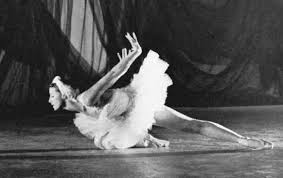
From the beginning, Maya was a different kind of ballerina. She spent very short time in the
corps de ballet after graduation and was quickly named a soloist. Her bright
red hair and striking looks made her a glamorous figure on and off the stage. Her long arms had a fluidity that to this day remains unmatched; her interpretation of
The Dying Swan, a short showcase piece made famous by
Anna Pavlova, became Maya's calling card. Maya was known for the height of her jumps, her extremely flexible back, the technical strength of her dancing, and her charisma. She excelled both in adagio and allegro, which is very unusual in dancers.

Despite her acclaim, Maya was not treated well by the Bolshoi management. She was
Jewish[1] in an
anti-Semitic climate, her family had been purged during the Stalinist era and her personality was defiant, so she was not allowed to tour outside the country for six years after joining the Bolshoi.
[2] It wasn't until 1959 that
Nikita Khrushchev permitted her to travel abroad,
[5] and Plisetskaya could tour internationally. Her ability changed the world of ballet, setting a higher standard for ballerinas both in terms of technical brilliance and dramatic presence.
In the 1980s, Plisetskaya and Shchedrin spent much time abroad, where she worked as the artistic director of the Rome Opera Ballet in 1984–5, then the Spanish National Ballet of
Madridfrom 1987–9. At the age of 65, she finally retired from the Bolshoi as a soloist. On her 70th birthday, she debuted in Béjart's piece choreographed for her and entitled "Ave Maya". Since 1994, she has been presiding over the annual international ballet competitions called
Maya. In 1996 she was named President of the Imperial Russian Ballet.
[7]

On her 80th birthday, the
Financial Times summed up current opinion about Maya in the following words: "She was, and still is, a star, ballet's
monstre sacre, the final statement about theatrical glamour, a flaring, flaming beacon in a world of dimly twinkling talents, a beauty in the world of prettiness."
[8] The following year, Emperor
Akihito presented to her the
Praemium Imperiale, informally considered a
Nobel Prize for Art. Later in life while touring in the United States she joined the fight for women's rights.

Nenhum comentário:
Postar um comentário